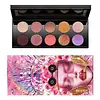What's inside
What's inside
 Key Ingredients
Key Ingredients

 Benefits
Benefits

No benefits
 Concerns
Concerns

 Ingredients Side-by-side
Ingredients Side-by-side

Talc
AbrasiveMica
Cosmetic ColorantOctyldodecyl Stearoyl Stearate
EmollientZinc Stearate
Cosmetic ColorantDimethicone
EmollientChlorphenesin
AntimicrobialPotassium Sorbate
PreservativeTin Oxide
AbrasiveDimethiconol
EmollientTetrasodium EDTA
CI 77891
Cosmetic ColorantIron Oxides
Ptfe
Polyethylene
AbrasiveSynthetic Fluorphlogopite
Triethoxycaprylylsilane
Hdi/Trimethylol Hexyllactone Crosspolymer
Caprylyl Glycol
EmollientEthylhexylglycerin
Skin ConditioningSilica
AbrasiveCI 75470
Cosmetic ColorantSqualane
EmollientOctyldodecanol
EmollientCalcium Sodium Borosilicate
Phenyl Trimethicone
Skin ConditioningHydrogenated Styrene/Isoprene Copolymer
Trimethylsiloxysilicate
EmollientPentaerythrityl Tetra-Di-T-Butyl Hydroxyhydrocinnamate
AntioxidantNeopentyl Glycol Dicaprylate/Dicaprate
EmollientPEG-12 Dimethicone
Skin ConditioningSorbitan Isostearate
EmulsifyingDimethicone/Vinyl Dimethicone Crosspolymer
Skin ConditioningGlycerin
HumectantPolysorbate 60
Emulsifying1,2-Hexanediol
Skin ConditioningXanthan Gum
EmulsifyingChondrus Crispus Extract
Skin ConditioningHydrogenated Lecithin
EmulsifyingSodium Citrate
BufferingCI 77491
Cosmetic ColorantCI 77007
Cosmetic ColorantCI 42090
Cosmetic ColorantCI 77510
Cosmetic ColorantCI 77742
Cosmetic ColorantCI 19140
Cosmetic ColorantCI 15850
Cosmetic ColorantNylon-12
Polyisoprene
Alumina
AbrasiveCalcium Titanium Borosilicate
AbrasiveTalc, Mica, Octyldodecyl Stearoyl Stearate, Zinc Stearate, Dimethicone, Chlorphenesin, Potassium Sorbate, Tin Oxide, Dimethiconol, Tetrasodium EDTA, CI 77891, Iron Oxides, Ptfe, Polyethylene, Synthetic Fluorphlogopite, Triethoxycaprylylsilane, Hdi/Trimethylol Hexyllactone Crosspolymer, Caprylyl Glycol, Ethylhexylglycerin, Silica, CI 75470, Squalane, Octyldodecanol, Calcium Sodium Borosilicate, Phenyl Trimethicone, Hydrogenated Styrene/Isoprene Copolymer, Trimethylsiloxysilicate, Pentaerythrityl Tetra-Di-T-Butyl Hydroxyhydrocinnamate, Neopentyl Glycol Dicaprylate/Dicaprate, PEG-12 Dimethicone, Sorbitan Isostearate, Dimethicone/Vinyl Dimethicone Crosspolymer, Glycerin, Polysorbate 60, 1,2-Hexanediol, Xanthan Gum, Chondrus Crispus Extract, Hydrogenated Lecithin, Sodium Citrate, CI 77491, CI 77007, CI 42090, CI 77510, CI 77742, CI 19140, CI 15850, Nylon-12, Polyisoprene, Alumina, Calcium Titanium Borosilicate
 Reviews
Reviews

Ingredients Explained
These ingredients are found in both products.
Ingredients higher up in an ingredient list are typically present in a larger amount.
Ci 75470 is a bright-red pigment. It is AKA carmine.
Carmine is derived from insects such as the cochineal beetle. This ingredient has been used as a natural dye for over 2000 years.
Ci 77491 is also hydrated iron III oxide. It's sole purpose is to give a red/pink hue to products.
Iron III oxides are classified as inorganic chemicals for coloring.
Synthetically created Ci 77491 is considered safer than those naturally found. This is because the synthetically created version may contain less impurities. Iron oxides are generally non-toxic and non-allergenic.
Learn more about CI 77491Ci 77891 is a white pigment from Titanium dioxide. It is naturally found in minerals such as rutile and ilmenite.
It's main function is to add a white color to cosmetics. It can also be mixed with other colors to create different shades.
Ci 77891 is commonly found in sunscreens due to its ability to block UV rays.
Learn more about CI 77891Mica is a naturally occurring mineral used to add shimmer and color in cosmetics. It can also help improve the texture of a product or give it an opaque, white/silver color.
Serecite is the name for very fine but ragged grains of mica.
This ingredient is often coated with metal oxides like titanium dioxide. Trace amounts of heavy metals may be found in mica, but these metals are not harmful in our personal products.
Mica has been used since prehistoric times throughout the world. Ancient Egyptian, Indian, Greek, Roman, Aztec, and Chinese civilizations have used mica.
Learn more about MicaSilica, also known as silicon dioxide, is a naturally occurring mineral. It is used as a fine, spherical, and porous powder in cosmetics.
Though it has exfoliant properties, the function of silica varies depending on the product.
The unique structure of silica enhances the spreadability and adds smoothness, making it a great texture enhancer.
It is also used as an active carrier, emulsifier, and mattifier due to its ability to absorb excess oil.
In some products, tiny microneedles called spicules are made from silica or hydrolyzed sponge. When you rub them in, they lightly polish away dead skin layers and enhance the penetration of active ingredients.
Learn more about SilicaTalc is a clay mineral. It helps absorb moisture and improve the texture of products. Like other types of clay, Talc can have a slight exfoliating effect on skin. Talc can be added to increase the volume of products.
Some Baby powders are made by combining talc with corn starch. The word "talc" comes from Latin and originates from Arabic. Talc is a mineral commonly found throughout the world.
If you have any concerns about using talc, we recommend checking out the FDA's official page.
Learn more about TalcTin Oxide is an inorganic oxide used to add opacity and volume to a product. In nature, it is already found in mineral form. The main ore of tin is an opaque and shiny mineral called casseterite.
Tin Oxide helps remove translucency in a product, or make it more opaque. Besides adding opacity, tin oxide is used for bulking to add volume.
Zinc Stearate is the metal salt of stearic acid. It is a white solid used to bind, thicken, and lubricate products.
This ingredient is common in powder makeup, where it helps keep the powder together.
Zinc Stearate is hydrophobic and repels water.
This ingredient can be sourced from non-animal or animal sources. It is best to reach out to the brand to see where they source this ingredient from.
Learn more about Zinc Stearate